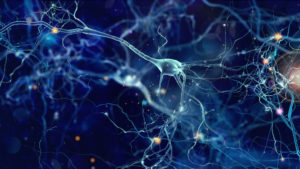In 2006, I was doing research into how negative thinking can impact your health. Completely unexpectedly, I landed on the topic of neuroplasticity. Neuroplasticity is the ability of the brain to be molded or changed, basically that it has plastic qualities.
For years, scientists thought the brain didn’t change past adulthood, past the late teenage years. Although there was legitimate thinking behind why the brain may not be able to grow and change, modern neurology and science has literally changed what people think about thinking. Science is finally proving what Buddhists have known for thousands of years – that our brains are not hardwired and that they can change.
How does this happen and what does this have to do with habits?
Well, let’s start in the brain.
The adult human brain is about 2% of your total body weight and is often described as having the consistency of tofu. In the brain are cells called neurons. Your brain has 86 billion of them. They are all connected to each other and amongst them, they make up trillions of connections in your brain. Neurons control every thing you do – from being conscious and breathing without you realizing it to picking up your water glass to thinking about what to eat to doing a workout to thinking negative thoughts, and so on.
When you have a thought (to pick up a water glass, to go for a workout, to pick up a pencil, to judge yourself for how you look, to keep overthinking a situation, and so on), a signal passes back and forth between the various neurons responsible for that thought. And because your brain is always trying to become more efficient, every time these two neurons communicate, every time you repeat this thought or pattern or activity, the brain builds a connection that makes it easier and easier and easier for these 2 cells to talk to each other in the future.
It’s almost like a little path is being carved out in your brain every time you think or do the same thing.
To create more of a visual, think of this path in the picture as if it’s a path in your brain. At one point this path was covered with trees and leaves and branches. But over time, as a result of having walked over it multiple times, having repeated the same behaviour (maybe reaching for that cookie at 3pm or judging yourself for not fitting into that outfit), a path was created and now it’s easier to get from A to B. This path has physically changed the shape of the forest, just like repetitive thoughts and behaviours create paths in your brain.
This means that how you think, what you think, can not only impact what you do, but it can physically change the shape of your brain.
Now, because this path is easier to follow since it’s a path that’s been taken multiple times (or a habit that’s been repeated multiple times), your brain is now more efficient and can think about other things. It doesn’t have to spend extra time and energy figuring out how to maneuver through the forest.
But this efficiency is not always necessarily a good thing. It means your brain can send messages across this path without you even really thinking about it.
And this is a habit – the result of having thought or done the same thing over and over to the point where you don’t even think about it anymore, to the point where you reach for that cookie without even being aware of it., where you eat too much food without even being aware of it., where you judge your body without even being aware of it.
Alright, enough with the neuroscience! How do you change a habit?!
To change a habit, you just need to create a new path. I don’t say ‘just’ meaning it’s always an easy thing to do. I say ‘just’ because the overall process behind changing a habit is actually quite simple.
How do you go about creating a new path? You literally shift the way you think. Here are 3 ways to do it:
1. Train your brain.
You want to get in the right headspace for habit change. So you’re basically going to give your brain a little workout by changing up little habits here and there. Here are a few suggestions:
- Anytime you hold a glass of water or whatever your beverage is of choice, use your left instead of your right or vice versa.
- If you put on your pants every morning by stepping into the RIGHT leg first, then start with your LEFT leg instead.
- In the gym, or during your workout, start your exercises with your LEFT instead of your RIGHT.
- If you take a certain route to work every morning, start taking a different one. Change it up everyday.
- Brush your teeth with your left hand instead of your right. (Just make sure you’re still doing a good job!)
- Sleep on the opposite side of the bed than the one you’re used to.
These are all little steps towards training your brain for positive change. They may or may not have to do with your exact goal, but they’re still supporting your brain for habit change.
2. Have intention.
You need to want to change your habits. It might sound silly to say, but not everybody really wants change. Sometimes people are truly more comfortable in their current situation, they might fear success or the attention that results from hitting their goals, or they might be uncertain of how to maintain success in the new, unfamiliar territory when they get there, and don’t want to fail at not succeeding long term.
When I had chronic migraines, I was throwing up 3-6 days a month, completely out of commission, lying on the bathroom floor as much as I was lying in bed. You can imagine that I was willing to do anything to get rid of them. I had intention.
And despite others in my family getting migraines, I wasn’t of the belief that I had to be stuck with them forever or that migraine headaches were a pre-determined outcome. And as I learned more about how the body worked, I realized why that was true.
I had to change so many things about my lifestyle – what I ate, how often I cooked, how much sugar I ate, how much exercise I did, and so on – but I can say to this day, many of my healthy habits (avoiding sugar, not exercising too much, eating protein and fat regularly to balance my blood sugar, mindfully breathing, not getting stuck in negative thinking) are the result of me taking the steps to avoid migraines.
3. Pay attention.
The second part of changing habits and creating long-lasting change is that you have mindfully listen to your body.
You need to pay attention to how your body and mind respond to change. When you’re mindful of how change impacts you, you become more aware of how to tweak or tailor your actions to get the results you want.
In the early 2000s, I was a trainer and news came out that if you focused on doing bicep curls, rather than just haphazardly doing them without paying attention, you would get better results. Turns out it’s true. Attention amplifies activity in those neurons and that attention necessary for neuroplasticity or change to happen. If no attention is paid, then there’s no change in the brain (cortex). In other words, neuroplasticity (behaviour change) occurs only when the mind is in a particular mental state – one with attention and focus.
For example, in November, I had a surgery on my big toe. As a result, there is obvious inflammation in the joint. Over the past 7 weeks, I have learned – without a shadow of a doubt – that anytime I eat cheese or dairy, my toe joint is inflamed. This means movement is restricted in the joint and if you know anything about anatomy and physiology, it also means that my restricted toe movement can impact my entire posture when I stand or walk. So if I don’t want inflammation in my foot, I don’t eat cheese! But I wouldn’t know that if I wasn’t paying attention.
***
As a Coach, I have one more piece of advice: Get educated.
When we educate ourselves about any situation (health, finances, travel, etc), we get more information on how things work. We get a broader perspective of what’s happening. We start to see the bigger picture and how all of the little pieces fit together. With more knowledge, we end up with a greater sense of control, which in turn can help to reduce stress and worry. And with more knowledge, we simply just end up making more informed decisions. And when it comes to health and reaching common goals like weight loss, it means we rely less on fad diets and exercise trends and risky behaviours to get the results we want.
Now, when I say ‘Get educated’, I don’t mean you should rely on a search engine for advice!
Instead, find a Coach, a Trainer, a Counsellor, a Therapist, any expert who will educate you, motivate you, encourage you, to reach the goals you want.
It’s time to shift the way you think about habit change. If you want it, you need to literally put your mind to it, and you can have it.
Wishing you all the success in the world. 💕



